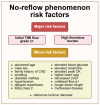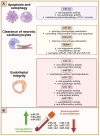Advances in Pathophysiology and Novel Therapeutic Strategies for Coronary No-Reflow Phenomenon
- PMID: 40722785
- PMCID: PMC12293017
- DOI: 10.3390/biomedicines13071716
Advances in Pathophysiology and Novel Therapeutic Strategies for Coronary No-Reflow Phenomenon
Abstract
Coronary no-reflow (CNR) is the failure of blood to reperfuse ischemic myocardial tissue after restoration of the vasculature. CNR poses a significant clinical challenge in the treatment of patients with ST-segment elevation myocardial infarction (STEMI), as it increases mortality and the risk of major adverse cardiac events (MACEs). Myocardial ischemia with subsequent reperfusion results in severe damage to the cardiac microcirculation. The pathophysiological causes of CNR include cardiomyocyte vulnerability, capillary and endothelial damage, leukocyte activation, reactive oxygen species (ROS) production, and changes in microRNA profiles and related gene expression. The impact of percutaneous coronary intervention (PCI) on the occurrence of CNR cannot be overlooked, as it can provoke distal atherothrombotic embolization. Current standards of pharmacological therapy for CNR are confined to intracoronary vasodilators and antiplatelet agents. As our understanding of the pathogenesis of the CNR phenomenon improves, opportunities emerge for developing novel therapeutic strategies. The following literature review provides an overview of the pathophysiology of the no-reflow phenomenon (based on animal and preclinical studies), contemporary treatment trends, and current therapeutic approaches.
Keywords: animal models; coronary no-reflow; ischemia/reperfusion injury; microvascular obstruction; myocardial infarction; pathophysiology.
Conflict of interest statement
The authors declare no conflicts of interest.
Figures




Similar articles
-
Effect of intracoronary agents on the no-reflow phenomenon during primary percutaneous coronary intervention in patients with ST-elevation myocardial infarction: a network meta-analysis.BMC Cardiovasc Disord. 2018 Jan 10;18(1):3. doi: 10.1186/s12872-017-0722-z. BMC Cardiovasc Disord. 2018. PMID: 29320987 Free PMC article. Review.
-
Adenosine and verapamil for no-reflow during primary percutaneous coronary intervention in people with acute myocardial infarction.Cochrane Database Syst Rev. 2015 May 18;2015(5):CD009503. doi: 10.1002/14651858.CD009503.pub3. Cochrane Database Syst Rev. 2015. PMID: 25985145 Free PMC article.
-
The Association of Plasma Osmolarity With No-Reflow in Patients With ST-Segment Elevation Myocardial Infarction: A Retrospective Cohort Study.Cureus. 2025 Jun 22;17(6):e86521. doi: 10.7759/cureus.86521. eCollection 2025 Jun. Cureus. 2025. PMID: 40698226 Free PMC article.
-
Adenosine and verapamil for no-reflow during primary percutaneous coronary intervention in people with acute myocardial infarction.Cochrane Database Syst Rev. 2013 Jun 4;(6):CD009503. doi: 10.1002/14651858.CD009503.pub2. Cochrane Database Syst Rev. 2013. Update in: Cochrane Database Syst Rev. 2015 May 18;(5):CD009503. doi: 10.1002/14651858.CD009503.pub3. PMID: 23736949 Updated.
-
PCSK-9 Inhibitors Can Significantly Improve the Coronary Slow Flow Caused by Elevated Lipoprotein (a) in ST-Elevation Myocardial Infarction Patients With Chronic Kidney Disease.Catheter Cardiovasc Interv. 2025 Jul;106(1):396-407. doi: 10.1002/ccd.31543. Epub 2025 Apr 25. Catheter Cardiovasc Interv. 2025. PMID: 40277036 Free PMC article.
References
-
- Roth G.A., Mensah G.A., Johnson C.O., Addolorato G., Ammirati E., Baddour L.M., Barengo N.C., Beaton A.Z., Benjamin E.J., Ben-ziger C.P., et al. Global Burden of Cardiovascular Diseases and Risk Factors, 1990–2019: Update From the GBD 2019 Study. J. Am. Coll. Cardiol. 2020;76:2982–3021. doi: 10.1016/j.jacc.2020.11.010. - DOI - PMC - PubMed
-
- Mandelzweig L., Battler A., Boyko V., Bueno H., Danchin N., Filippatos G., Gitt A., Hasdai D., Hasin Y., Marrugat J., et al. The second Euro Heart Survey on acute coronary syndromes: Characteristics, treatment, and outcome of patients with ACS in Europe and the Mediterranean Basin in 2004. Eur. Heart J. 2006;27:2285–2293. doi: 10.1093/eurheartj/ehl196. - DOI - PubMed
Publication types
LinkOut - more resources
Full Text Sources
Research Materials
Miscellaneous

